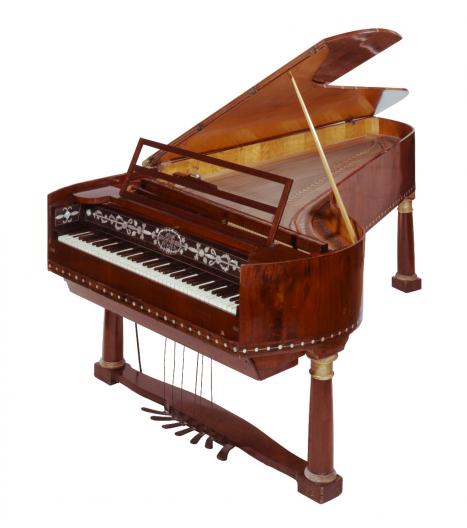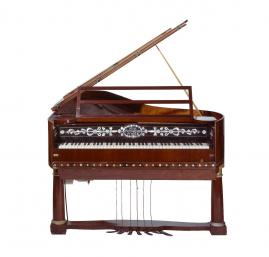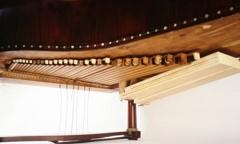Organ Piano by Joseph Böhm,
Vienna 1821 or subsequent years


Wien vor 1830

Wien vor 1830
One of the few remaining hammer pianos that features an organ rank. The overblowing flute rank gives the sound of the piano a magical quality. With the other timbral alterations of this instrument, such as Janissaries, bassoon, moderator, and dampers, the musicians had sound possibilities at their disposal that added special dimensions to the performance of variations or illustrative music, for example. There is also a pedal for operating the bellows mechanism as well as another for playing the organ register alone or together with the piano.
Böhm was an extraordinarily innovative piano builder, and such hammer pianos with an additional organ rank were not his only innovation. His inventions also included a transposition mechanism and a page-turning device. A reference to Böhm's first hammer pianos with flute rank points to the year 1821:
"In 1821, the piano maker Jos. Böhm in Vienna completed a pianoforte, which contains a a 5 1/2 octave flute rank, which pipes lie horizontally on the base, so that either one can be played alone or both together." (Stefan Edler von Keeß: Darstellung des Fabriks- und Gewerbswesens welche in den Fabriken, Manufacturen und Gewerben des österreichischen Kaiserstaates erzeugt werden Mit einem vollständigen Grundrisse der Technologie vorzüglich in technischer Beziehung 2, Wien 1823, p. 199)
Since the production of such an instrument was particularly elaborate and costly, it is likely that only a few such organ pianos were made. It is rather unlikely that our instrument is the one mentioned from 1821, as the range of the organ rank does not match this description (see image); and doubts may arise about how another one and a half octaves of pipes more could still be arranged under the bottom. The rounded body shape, as seen here, is also characteristic of the years before 1830, and was later replaced by an angular form with pronounced corners.
In terms of construction and mechanics, the instrument is extraordinarily well-crafted. Joseph Böhm demonstrates his craftsmanship and creative power in piano construction. The instrument is also significant for music research because the organ pipes provide a clear contemporary pitch reference.
Essay on Historical Pitch Standards
by Dr. Erich Tremmel
The historical tuning guide for this instrument, written in Italian, suggests it was likely originally made for a client in the Italian-speaking crown territories of the k.k. Austrian empire. However, since the instrument would no longer reliably withstand a strings' tuning to this determined pitch of 432 Hz, a special task was to create a set of new organ pipes according to the old dimensions at a lower pitch, so that the instrument with its special sound possibilities can be experienced anew at a lower pitch standard.
Musical interpretation is largely determined by the sound platform. The sound variations allowed by this piano offer a wealth of expressive possibilities that are difficult to achieve in other ways. The craftsmanship of the instrument is just as important as the music cultural context in which instruments like this have developed their effects.
Technical sound variations, particularly the rich "mutations" available here, have been debated artistically time and again, apart from the "Forte" (dampers) and "Piano" (shift or moderator) pedals. Nevertheless, such means of expression have also been viewed by some as essential elements and enrichments of the expressive capabilities of the pianoforte, which were often accompanied by higher prices. Therefore, buyers of such instruments have deliberately sought these sound possibilities, and this continues to demonstrate that those mutations contributed significantly to the historical interpretation of piano music, especially in the first half of the 19th century.



